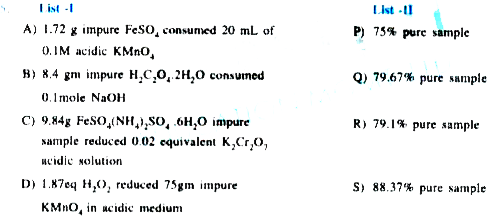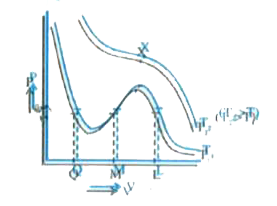For the following reaction
N2+3H2→2NH3 equivalent mass of N2=molar mass ofN2X
What is the value of x.Solution in Telugu
The correct Answer is:6
Step by step video, text & image solution for For the following reaction N_(2)+3H_(2)to2NH_(3) equivalent mass of N_(2)=("molar mass of" N_(2))/X What is the value of x. by Chemistry experts to help you in doubts & scoring excellent marks in Class 12 exams.
Topper's Solved these Questions
- BOOK - AAKASH SERIESCHAPTER - STOICHIOMETRYEXERCISE - LECTURE SHEET ( EXERCISE IV STRAIGHT OBJECTIVE TYPE QUESTIONS)10videos
STOICHIOMETRY
- BOOK - AAKASH SERIESCHAPTER - STOICHIOMETRYEXERCISE - LECTURE SHEET ( EXERCISE IV MORE THAN ONE TYPE QUESTIONS)3videos
STOICHIOMETRY
- BOOK - AAKASH SERIESCHAPTER - STOICHIOMETRYEXERCISE - LECTURE SHEET ( EXERCISE III MATRIX MATCHING TYPE QUESTIONS)2videos
STOICHIOMETRY
- BOOK - AAKASH SERIESCHAPTER - STATES OF MATTER EXERCISE - ADDITIONAL PRACTICE EXERCISE -PRACTICE SHEET (ADVANCED) (LINKED COMPREHENSION TYPE QUESTIONS) (PASSAGE- IV)2videos
STATES OF MATTER
- BOOK - AAKASH SERIESCHAPTER - SURFACE CHEMISTRYEXERCISE - Objective Excersice - 4 (ASSERTION (A)& REASON (R ) TYPE QUESTION)34videos
SURFACE CHEMISTRY
Similar Questions
500 ml of a 0.1 N solution of AgNO3 added to 500 ml of 0.1 N solution of KCl.The concentration of nitrate ion in the resulting mixture is
00:58View SolutionWhich relation involve iodimetric titration?
02:01View Solution View Solution
View SolutionAt a particular temperature and pressure for a real gas Van der Waal's equation can be written as:
(P+aV2m)(Vm−b)=RT

where Vm is molar volume of gas. This is cubic equation in the variable Vm and therefore for any single value of P & T there should be 3 values of Vm. Which are shown in graph as Q, M and L.
As temperature is made to increase at a certain higher temperature the three values of Vm becomes identical. The temperature, pressure & molar volume at point X are called Tc, Pc & Vc for real gas. The compressibility factor in terms of Pc, Vc and T is called Zc.
The expression of Van dcr Waal's constant 'a' can be given as05:39View Solution(A) De-emulsification is a reverse process of emulsion formation
(R ) During de-emulsification , the emulsion breaks to give oil and water.03:11View SolutionFor the reaction N_(2)(g)+3H_(2)(g)to2NH_(3)(g) , which of the following is correct regarding DeltaH ?
01:25View SolutionWrite expression for rate of reaction in terms of each reactant and product for the reaction N_(2)+3H_(2)to2NH_(3) .
View Solution5g H_(2) is allowed to react with 14 g N_(2) for the following reaction. N_(2)(g)+3H_(2)(g)rarr2NH_(3)(g) What mass of H_(2) will be left unreached at the end of reaction?
01:22View SolutionIn the following reaction, we start with 2 mol of N2 and 5 mol of H2 exerting a total pressure of 7 atm at a given temperature is a closed vessel. When 50% of N2 is converted into NH3.
N2+3H2→2NH3
Partial pressure of NH3 is:02:09View SolutionFor reaction, N_(2)(g)+3H_(2)(g) rarr 2NH_(3)(g) , ratio of molecular mass of N_(2) to equivalent mass of N_(2) is________.
01:22View SolutionN_(2) + 3H_(2) to 2NH_(3) In this reaction, equivalent weight of N_(2) is :
02:09View SolutionN_(2)+3H_(2)to2NH_(3) , name the type of reaction.
01:37View SolutionThe rate of reaction for N_(2)+3H_(2)to2NH_(3) may be represented as
02:47View SolutionFor N2+3H2→2NH3 rates of disappearance of N2 and H2 and rate of appearance of NH3 respectively, are a,b and c then
02:38View SolutionThe rate of reaction for N2+3H2→2NH3 may be represented as
02:37View Solution

